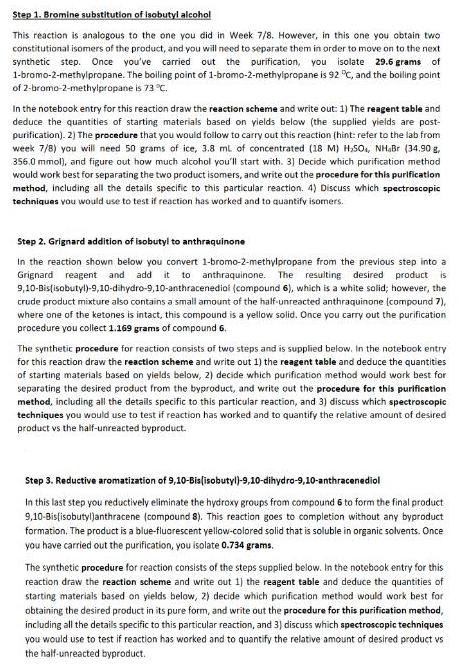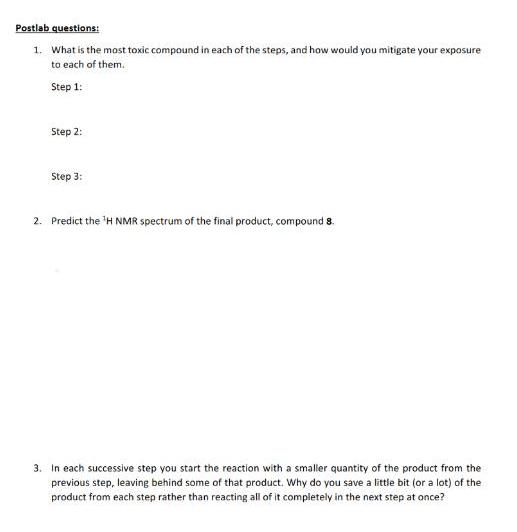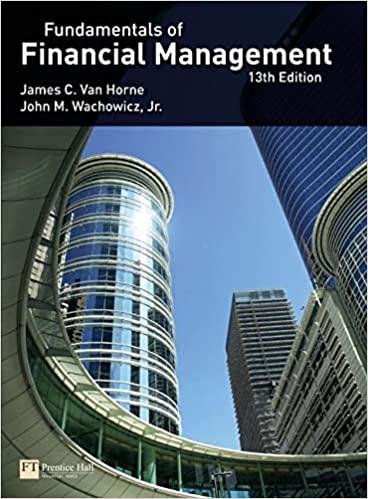Answered step by step
Verified Expert Solution
Question
1 Approved Answer
Step 1. Bromine substitution of isobutyl alcohol This reaction is analogous to the one you did in Week 7/8. However, in this one you


Step 1. Bromine substitution of isobutyl alcohol This reaction is analogous to the one you did in Week 7/8. However, in this one you obtain two constitutional isomers of the product, and you will need to separate them in order to move on to the next synthetic step. Once you've carried out the purification, you isolate 29.6 grams of 1-bromo-2-methylpropane. The boiling point of 1-bromo-2-methylpropane is 92 C, and the boiling point of 2-bromo-2-methylpropane is 73 C. In the notebook entry for this reaction draw the reaction scheme and write out: 1) The reagent table and deduce the quantities of starting materials based on yields below (the supplied yields are post- purification). 2) The procedure that you would foilow to carry out this reaction (hint: refer to the lab from week 7/8) you will need 50 grams of ice, 3.8 ml of concentrated (18 M) H,SO, NHaBr (34.90 g, 356.0 mmol), and figure out how much alcohol you'll start with. 3] Decide which purification method would work best for separating the two product isomers, and write out the procedure for this purification method, Including all the details specific to this particular reaction. 4) Discuss which spectroscopic techniques vou would use to test if reaction has worked and to quantify isomers. Step 2. Grignard addition of isobutyl to anthraquinone In the reaction shown below you convert 1-bromo-2-methylpropane from the previous step into a Grignard reagent and add it to anthraquinone. The resulting desired product is 9,10-Bis(isobutyl)-9,10-dihydro-9,10-anthracenediai (compound 6), which is a white solid; however, the crude product mixture also contains a small amount of the half-unreacted anthraquinone (compound 7), where one of the ketones is intact, this compound is a yellow solid. Once you carry out the purification procedure you collect 1.169 grams of compound 6. The synthetic procedure for reaction consists of two steps and is supplied below. In the notebook entry for this reaction draw the reaction scheme and write out 1) the reagent table and deduce the quantities of starting materials based on yields below, 2) decide which purification method would work best for separating the desired product from the byproduct, and write out the procedure for this purification method, including all the details specific to this particular reaction, and 3) discuss which spectroscopic techniques you would use to test if reaction has worked and to quantify the relative amount of desired product vs the half-unreacted byproduct. Step 3. Reductive aromatization of 9,10-Bia[isobutyl)-9,10-dihydro-9,10-anthracenediol In this last step you reductively eliminate the hydroxy groups from compound 6 to form the final product 9,10-Bis[isobutyljanthracene (compound 8). This reaction goes to completion without any byproduct formation. The product is a blue-fluorescent yelow-colored solid that is soluble in organic solvents. Once you have carried out the purification, you isolate 0.734 grams. The synthetic procedure for reaction consists of the steps supplied below. In the notebook entry for this reaction draw the reaction scheme and write out 1) the reagent table and deduce the quantities of starting materials based on yields below, 2) decide which purification method would work best for obtaining the desired product in its pure form, and write out the procedure for this purification method, including all the details specific to this particular reaction, and 3) discuss which spectroscopic techniques you would use to test if reaction has worked and to quantify the relative amount of desired product vs the half-unreacted byproduct. Postlab questions: 1. What is the most toxic compound in each of the steps, and how would you mitigate your exposure to each of them. Step 1: Step 2: Step 3: 2. Predict the 'H NMR spectrum of the final product, compound 8. 3. In each successive step you start the reaction with a smaller quantity of the product from the previous step, leaving behind some of that product. Why do you save a little bit (or a lot) of the product from each step rather than reacting all of it completely in the next step at once?
Step by Step Solution
★★★★★
3.49 Rating (159 Votes )
There are 3 Steps involved in it
Step: 1
Answer 1 step 1 The ammonium bromide is most toxic compound used in the step 1 The ammonium bromide ...
Get Instant Access to Expert-Tailored Solutions
See step-by-step solutions with expert insights and AI powered tools for academic success
Step: 2

Step: 3

Ace Your Homework with AI
Get the answers you need in no time with our AI-driven, step-by-step assistance
Get Started


